Ah, the luscious taste of strawberries straight from the garden – YUM! Unless they have a millipede inside: then it’s definitely BLECCCHHH! Millipedes aren’t toxic but they produce a highly irritant fluid when handled – or chewed! – that’s so foul-tasting and -smelling that many chickens won’t touch them, although apparently ducks will. Unfortunately, any duck that eats your millipedes will also eat everything else in your vegie garden!
Portuguese Millipedes snuck into Port Lincoln in South Australia in the early 1950s, and have since spread throughout Southern Australia. They’re herbivorous and do little damage to ornamental gardens, but damage seedlings and soft fruit in the vegie patch. Although they supposedly only attack fruit (such as strawberries) and root vegetables (potatoes, carrots) at ground level, the Olympians in my garden happily climb raspberry canes and two-metre (6 foot) high tomato vines. Tomatoes attacked by millipedes look like something out of a horror movie. Double blecchhh!
When they’re in plague proportions, as they were when we moved into our new home in the mid 1980s, they enter the house, climbing walls and ceilings, and falling onto your face as you sleep, or crunching underfoot during nocturnal loo visits. The recommended treatment at the time (and, surprisingly, one that’s still recommended) was to spray carbaryl around the walls of the house to kill them before they enter. Unfortunately, carbaryl also seemed to attract them, so every morning I swept literally a bucketful of dead millipedes from the paths around the house. In any case, we were so dismayed by the many other dead insects and spiders that we never again used this non-selective insecticide.
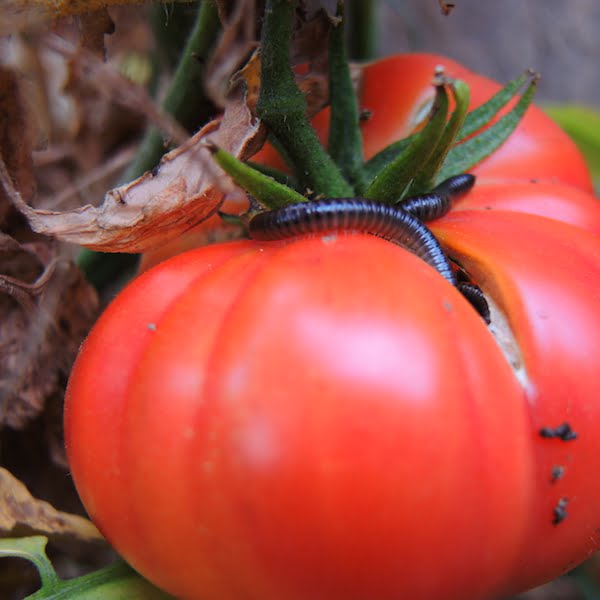
Olympian millipedes climb my 2m high tomato vines
Another time, I spread blue snailbait (methiocarb) widely in the garden beds around the house, and this was very effective, but I only did this once as well, because of the potential to poison non-target animals such as frogs, skinks and birds. I now sparingly use Multigard Snail Bait in the vegie patch, a very low-toxicity, more target-specific iron EDTA complex (iron chelate) bait that won’t affect worms, beneficial insects and animals – including pets – if used as directed.
In the late 80s, a parasitic nematode was distributed in my local area and, since then, numbers have never reached the same plague proportions. With better door seals and light-excluding curtains, we no longer get many in the house, even in autumn when numbers peak, and there are many other ways to combat them.
Outdoors, however, many of the physical controls (eg removing organic matter and mulch) are counterproductive. Most crops are safe in summer, but there are still enough millipedes around to damage susceptible plants like strawberries, especially after rain or in heavily irrigated crops where soil and mulch stay permanently moist. Knowing how attractive strawberries are to millipedes, I wonder about the chemicals that commercial growers in the Adelaide Hills use to control them.
Unsurprisingly, many Hills gardeners I know have given up on growing strawberries, but others have come up with clever ways to thwart the little buggers – one gardener told me he simply picks the strawberries just before they’re ready to eat, and ripens them indoors!
Diatomaceous earth is an effective, albeit expensive and time-consuming organic product to reapply. I use diatomaceous earth for seedlings, but wouldn’t use it in an extensive strawberry patch.
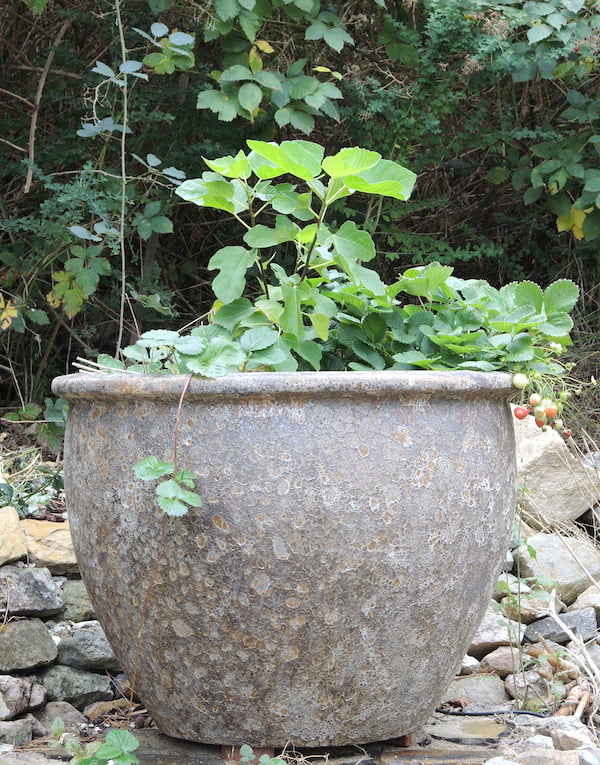
The strawberry plants in a tall pot around the fig have mostly escaped millipede damage
A light trap is another good idea – you can make your own, or buy one. I’ve not used one but it seems worth a try, so I’ll report back and let you know.
The most common way to exclude pests is to raise plants so the millipedes can’t reach them. One gardener grows them in an old bathtub because the sides are too slippery for them to scale, and even the plants I put around my fig tree in a 90 cm (3 foot) tall pot have largely (but not entirely) escaped the pest. My strawberry planters fared better than plants grown in the ground, but not as well as those in the tall pot.
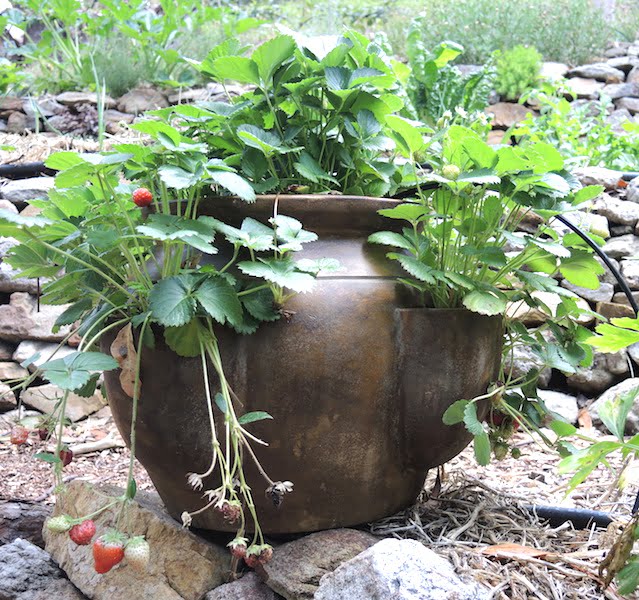
Strawberry planters still have some fruit hanging too close to the ground
Another gardener told me she grows them in planters, propped on upturned plastic pots in a water moat. Hanging baskets are effective too, as well as numerous variations on the PVC hanging planters either: vertical (Backyard Gardening, Handimania), or horizontal.
When you google, you’ll find lots of ingenious containers adapted for strawberry growing that would exclude millipedes, ranging from 44-gallon drums to woven fabric, timber, terracotta and almost any other combination of shape, size and material you can dream up !
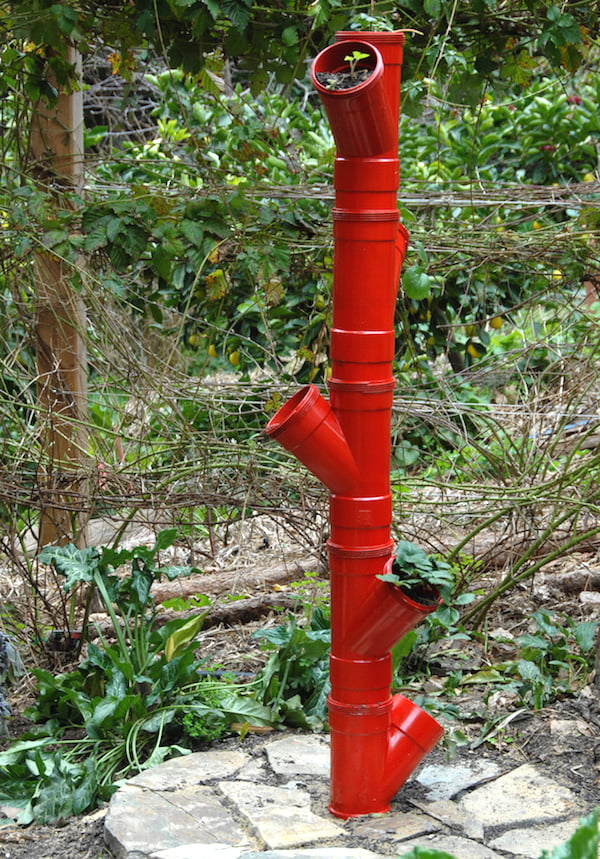
My newly built strawberry tree made from Y junction sewer pipes
So I thought I’d try a strawberry tree combining 100mm (4 inch) sewer pipe Y-junctions, plus pipe to make a 100mm (4 inch) section between each Y for a bigger volume of soil. It was less than one hour’s work to assemble because I didn’t glue the sections together: if this one worked, I planned to relocate it and build several more to create a little forest of them in bright primary colours. I hammered two short star droppers into the ground, slid the tree onto it and spray painted it red. When it was dry, I filled with good quality, dampened potting mix, planting the runners from the bottom up as I went. Then I wound 4mm irrigation line up the tree, placing a junction at each opening with a dripper. This was connected to an irrigation station watering once every three days – not quite enough in very hot weather, but adequate. To pretty it up, I paved a circle around the base. It turned out very stable with no chance of toppling.
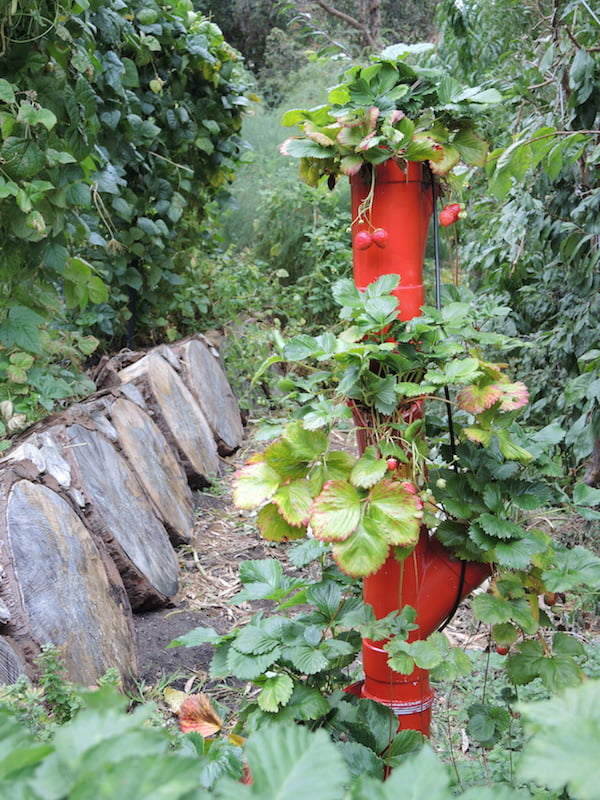
Lots of undamaged strawberries ready to harvest
I fertilised regularly with fish emulsion (Powerfeed for vegies) and Seasol and harvested the best and cleanest crop of strawberries I’ve ever raised. Only the strawberries on the lowest plant were attacked by millipedes, and that was because the lowest Y was too close to the ground. As the sections aren’t glued, I can simply swap the bottom piece of pipe for a longer one.
I also read online that the strawberry plants will need replacing more often than ones in the ground, but I’ll try them for one more year and see how they go with my fertilising regime.
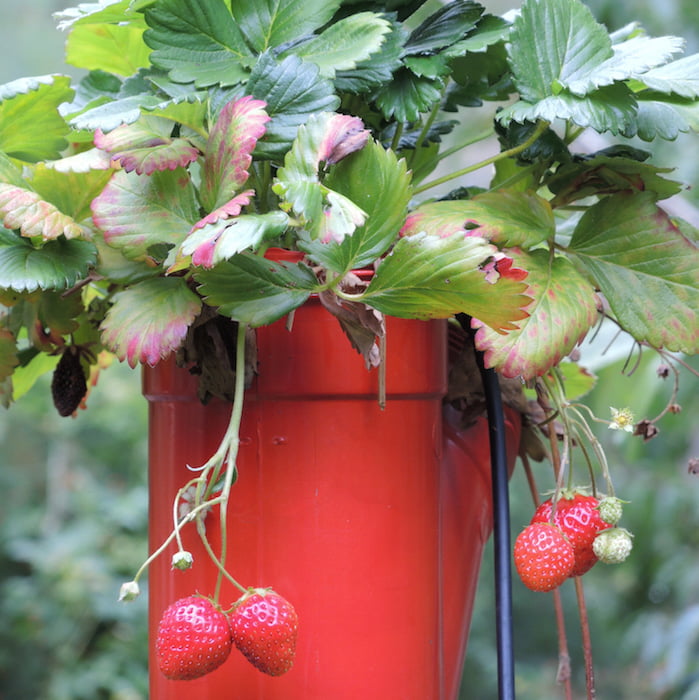
There’s nothing like home-grown strawberries
To sum up: the tree worked very well, but 150mm (6 inch) pipe would have been even better than 100mm (4 inch). However, the 100mm was available at my place of work (ie reasonably priced with staff discount; a 150mm pipe would only require holes drilling and would probably be cheaper). I’m also tempted to try some of the horizontal sewer pipe planters, which I could suspend from the cypress pine frames in the garden.
So for gardeners plagued by millipedes: don’t give up on your strawberries – there are plenty of container options around!
